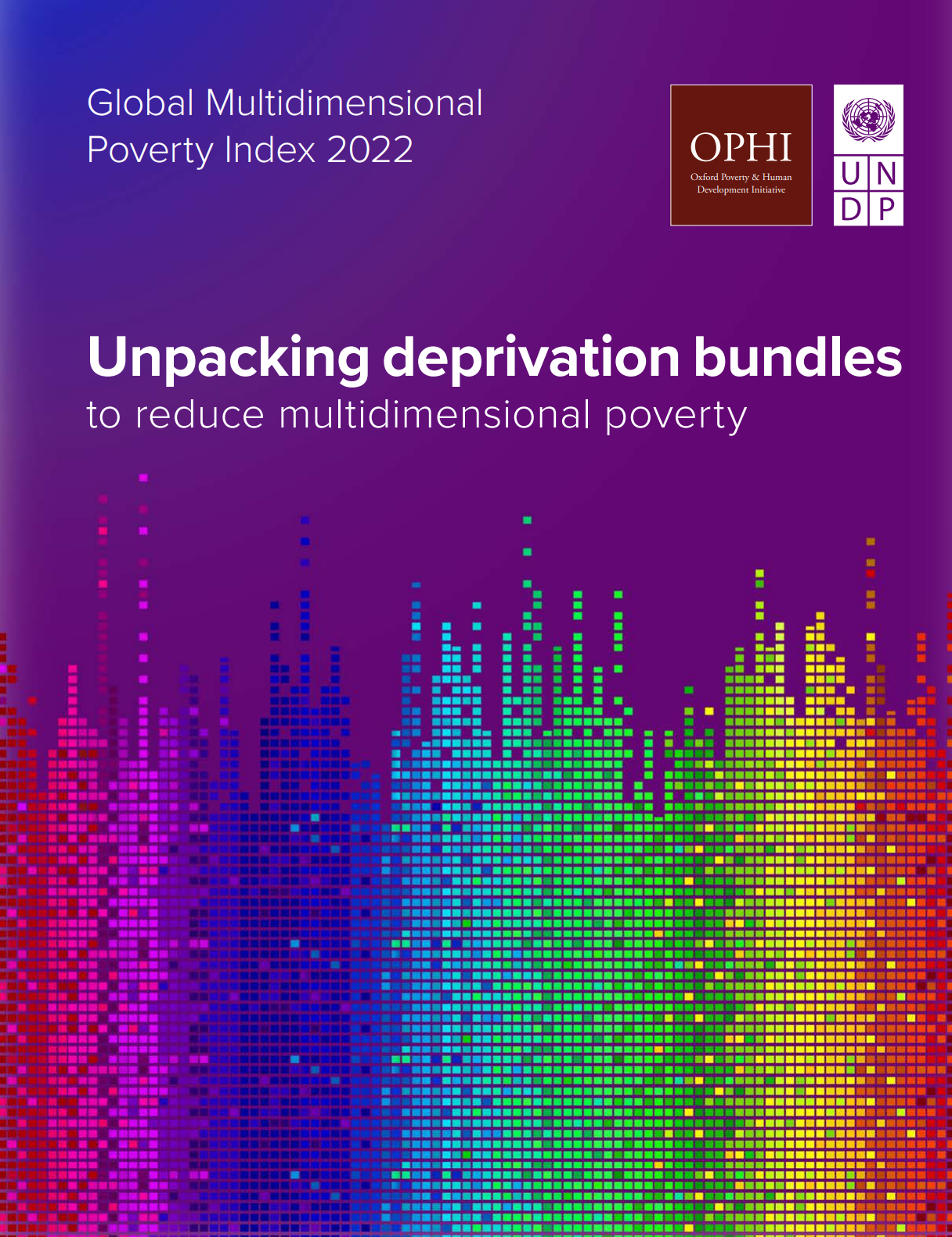Global MPI 2022
The global Multidimensional Poverty Index 2022 compares acute multidimensional poverty for 111 countries in developing regions. These countries are home to 6.1 billion people, three-quarters of the world’s population. Of these people, 1.2 billion (19.1%) are identified by the 2022 global MPI as multidimensionally poor.
The 2022 global MPI shows both who is poor – in terms of their age group, subnational region, and whether they live in an urban or rural area – and how they are poor – which overlapping deprivations they face and how many deprivations they have.
Our joint report
This year’s report, Global Multidimensional Poverty Index 2022: Unpacking deprivation bundles to reduce multidimensional poverty, produced in partnership with the United Nations Development Programme Human Development Report Office (UNDP HDRO), examines interlinkages, or the simultaneous interlinked deprivations which multidimensionally poor people face around the world. The report presents for the first time in-depth analysis of the possible combinations – or bundles – of deprivations across the ten indicators measured in the global MPI. The analysis investigates which interlinked deprivations are most frequent and where, and how they can be addressed with multisectoral approaches to poverty reduction.
- Citation: OPHI (Oxford Poverty and Human Development Initiative) and UNDP (United Nations Development Programme) (2022). Global Multidimensional Poverty Index 2022: Unpacking deprivation bundles to reduce multidimensional poverty. United Nations Development Programme and Oxford Poverty and Human Development Initiative.
Our data
The global MPI results are presented in eight tables. Data Table 1 presents MPI country (national) results using the most recent data from 111 countries, covering 6.1 billion people. The country (national) estimates are jointly produced by OPHI and UNDP’s Human Development Report Office (HDRO). Please refer to OPHI MPI Methodological Note 52 for the core methodology and country specifications.
In addition, the OPHI team produces an additional set of Data Tables (Data Tables 2–8). These include selected auxiliary statistics, namely, standard errors of key estimates consistently. Data Table 2 presents estimations for multiple poverty cut-offs as a measure of robustness. The MPI and its partial indices are also disaggregated by several different population groups: age groups (Data Table 3), rural and urban areas (Data Table 4), subnational regions (Data Table 5) and gender of household head (Data Table 7). The disaggregated MPI results shared in these tables show the importance of going beyond national averages to identify important variation across population groups. Please refer to OPHI MPI Methodological Note 53 for OPHI’s disaggregation methodology and policies.
Of interest to policymakers is the extent to which poverty has reduced over time. Data Table 6 presents trends over time in 84 countries. For 35 of these countries there are trends for three points in time, while one country, Gambia, has data for four. Data Table 6 also contains disaggregated results of the extent to which poverty has changed over time for age groups, rural and urban areas, and for 810 subnational regions. Please refer to OPHI MPI Methodological Note 54 for trends over time methodology and country harmonisation details.
Finally, Data Table 8 presents all global MPI country (national) results published since 2010.
Oxford Academic licence
Our Country Briefings
The global MPI Country Briefings present the country-specific results for the countries in this year’s global MPI.
Documentation
Technical Files
Our data preparation do-files allow you to generate the global MPI indicators from the microdata. This is the first technical step. Microdata are household surveys produced by specific survey providers such as DHS and MICS.
The technical files (or Stata do-files) for each country survey can be downloaded below. Please refer to OPHI’s Methodological Note series for information on survey details.
The do-files used for the purpose of generating the global MPI indicators are open access under the Oxford Academic licence.
Do-files as a zip package
The global MPI estimates are produced using the Stata package `mpitb` by Nicolai Suppa. For more information visit this paper. This is the second technical step. The package produces estimations by national, by population subgroups, e.g.: age groups, rural and urban areas, subnational regions and supports the estimation of levels and change between time periods. `mpitb` simplifies estimations and analyses in cross-country settings.
The package is available at the Statistical Software Components (SSC) Archive and on gitlab. The MPI toolbox is distributed free of charge under an MIT license. The package may be installed by issuing `ssc install mpitb` in Stata. To access its comprehensive help files issue `help mpitb` after the installation. `mpitb` requires Stata 16 or higher.
Download the technical files (or Stata do-files) for each country survey



